Here’s a guest post by a therapist who has been using ACT for clients with addictions for many years. Jaime highlights core principles using examples from his practice. I follow with a longish comment on aspects of ACT that I find especially important.
…by Jaime Booth Jenkins BSW MAPP…
“Between stimulus and response there is a space. In that space is our power to choose our response. In our response lies our growth and our freedom.” — Viktor E. Frankl
Acceptance and Commitment Therapy (ACT…pronounced “Act”) offers principles and techniques that can enable people to move beyond the addictive cycle…into their future. ACT arose in the ‘third wave’ of cognitive behaviour therapies and shares some fundamental principles with Dialectical Behaviour Therapy (DBT) and Mindfulness Based Cognitive Therapy (MBCT). The advantage of ACT for practitioners is the flexibility both in how it is delivered and the population it can serve. Unlike the prescriptive, manualized nature of DBT and MBCT, ACT has been shown to b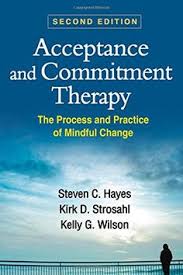 e effective for both groups and individuals, for a wide range of clinical issues, and it allows the clinician to adapt core techniques as needed.
e effective for both groups and individuals, for a wide range of clinical issues, and it allows the clinician to adapt core techniques as needed.
Addiction, from an ACT perspective, is a result of experiential avoidance — the avoidance of uncomfortable and unwanted thoughts or feelings. Having a few drinks to ease social anxiety, using heroin to ease the pain of failure or trauma, or using methamphetamine to avoid boredom or loneliness are examples of experiential avoidance. Addiction adds an insidious layer of complexity because shame, guilt, self-contempt, and physiological withdrawal become feelings people also try to avoid — sometimes desperately.
ACT is based on 6 core principles:
Acceptance – Uncomfortable thoughts and feelings happen. The goal is not to avoid them, block them out, or pretend they aren’t there, but to accept them, make space for them, and then continue on. When confronting addiction there are plenty of unwanted thoughts and feelings, but one of the most challenging is CRAVING.
William was a young college student who had been using methamphetamine initially to work late — but eventually for the high itself. He had attempted to quit several times but experienced intense cravings that would lead back to using. When he experienced a craving in the session, we practiced breathing into it and visualizing himself as a surfer “surfing the wave” of discomfort. [Note the overlap with Mindfulness-Based Relapse Prevention, coming up later.] The craving dissipated and he was able to continue the session. We practiced this every time cravings arose — and eventually they became less intense.
Cognitive Defusion [sic] – Have you ever repeated a word so often that it begins to sound funny or it completely loses its meaning? This is one way to promote cognitive defusion — to remove the (fused-together) meaning or context from thoughts, words, and feelings. Defusion creates space to regard thoughts and feelings from the perspective of a dispassionate observer, making it easier to let them go and allow more beneficial thoughts and feelings to take their place.
Andy was a high-powered lawyer with a cocaine addiction. He had an extreme reaction to the word “addict” and would go to great lengths to avoid labeling himself that way. The shame of the word itself increased his desire to use. To take the power out of the word we practiced a few different defusion techniques. Changing the words of Happy Birthday to “Happy Addict,” imaging a baby elephant saying the word or repeating it over and over in different tones and voices, it began to lose its meaning and therefore its power.
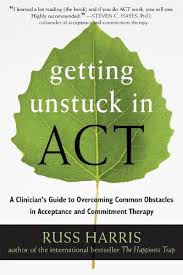 Being Present – Staying present in the face of uncomfortable internal or external stimuli, without judgement, can be difficult when coming out of an addiction. Painful thoughts and feelings can return without warning and overwhelm the individual.
Being Present – Staying present in the face of uncomfortable internal or external stimuli, without judgement, can be difficult when coming out of an addiction. Painful thoughts and feelings can return without warning and overwhelm the individual.
Every client I see is given a pack of Lifesaver candies (sweet little O’s, multi-coloured, etc). We then run through a simple “lifesaving” meditation in order to practice remaining in the present. Putting a candy in your mouth and focusing on what it looks like, tastes like and feels like allows you to return to the present. If a particularly painful rumination begins, pulling out a lifesaver is a quick and easy way to return to what’s actually happening in the present. Other therapists use other techniques to snap the client out of the “monkey chatter” of cycling thoughts and into the here-and-now.
The Observing Self – This is perhaps where Frankl’s space becomes the most literal, as it requires individuals to distance themselves from their thoughts and feelings and observe them as if they were a separate entity. Having these thoughts and feelings is normal, but this doesn’t make them valid or true.
Emily struggled with the shame associated with some of her actions while drunk. Self-deprecating thoughts about these actions would scream at her and pull her back into drinking. In order to help her regain control we 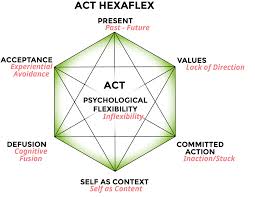 practiced a mindfulness activity in which she was laying on the ground and watching her thoughts float by like clouds. She simply watched, without judging or avoiding. This gave her the opportunity to see her thoughts as separate from herself, and gave her the space to decide whether to grab the thought or let it pass by.
practiced a mindfulness activity in which she was laying on the ground and watching her thoughts float by like clouds. She simply watched, without judging or avoiding. This gave her the opportunity to see her thoughts as separate from herself, and gave her the space to decide whether to grab the thought or let it pass by.
Values – It is not uncommon for an addiction to become the central unifying purpose of an individual’s life. This tends to obscure what is of real importance.
Claire was in my office because her employer noticed her showing up late for work, taking more breaks throughout the day, and taking more “sick days” than others in her position. She revealed to HR that she regularly drank 1-2 bottles of wine each evening and did not see a reason to stop as she was near retirement. It was not until we came to identify her core values — connecting closely with family and friends — that she was able to see the 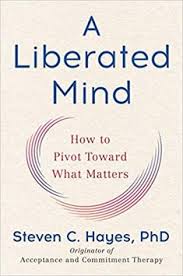 real impact of her addiction: it was pulling her farther away from them. So now, when she would experience a craving in the session, instead of focusing on not drinking, we would choose an image of interacting with her children as a focal point to move towards. Her value acted as a lighthouse that guided her through the craving. She was willing to experience the discomfort of craving because she knew, on the other side of it, her family was waiting, and she wanted that more than she wanted to avoid the discomfort.
real impact of her addiction: it was pulling her farther away from them. So now, when she would experience a craving in the session, instead of focusing on not drinking, we would choose an image of interacting with her children as a focal point to move towards. Her value acted as a lighthouse that guided her through the craving. She was willing to experience the discomfort of craving because she knew, on the other side of it, her family was waiting, and she wanted that more than she wanted to avoid the discomfort.
Committed Action – Once a space has been created and values identified we can begin to allow ourselves to be pulled by our future instead of pushed by our past.
Continuing work with Claire involved helping her to set goals that would allow her to live a life more aligned with her values. We set the goal of having interactions with her family or making plans with a friend without wine. Simple — and she much preferred how it felt, once she got used to it.
A silver bullet to “solve” addiction is something I have been searching for throughout my career. But there are likely as many silver bullets as there are individuals. What I have found in ACT is a framework that allows people to regain control, not over their addiction but over their thoughts, feelings, and actions. This control allows them to move in value-led directions — and their addiction can dissipate as a by-product. The work to get there is not easy — but it is certainly worth it.
Helpful Links:
Training/books by Russell Harris, an ACT-based practitioner/trainer.
Detailed outline of ACT, principles and practice, also by Russ Harris, from Psychotherapy.net.
Summary and links, Association for Contextual Behavioral Science.
Urge surfing…wrt addiction. From “Mindfulness with Dr. Walsh,” 2016.
Great interview (video) with Steven Hayes, by “Dr. Dave — The Science of Psychotherapy,” 2019.
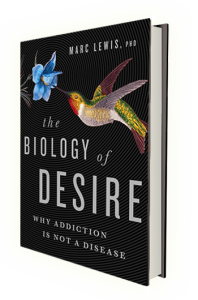 Informed by unparalleled neuroscientific insight and written with his usual flare, Marc Lewis’s The Biology of Desire effectively refutes the medical view of addiction as a brain disease. A bracing and informative corrective to the muddle that now characterizes public and professional discourse on this topic.” —Gabor Maté, M.D., author of In The Realm of Hungry Ghosts: Close Encounters With Addiction
Informed by unparalleled neuroscientific insight and written with his usual flare, Marc Lewis’s The Biology of Desire effectively refutes the medical view of addiction as a brain disease. A bracing and informative corrective to the muddle that now characterizes public and professional discourse on this topic.” —Gabor Maté, M.D., author of In The Realm of Hungry Ghosts: Close Encounters With Addiction
I’d like to add some of my own impressions. I’ve never practiced ACT per se in my work as a psychotherapist. I was never instructed in that tradition. But studying the online “immersion” course, listening to founder Steven Hayes explain and demonstrate how it works, I’ve found a lot of resonance with methods I learned years ago or picked up along the way. I think Hayes is not only an excellent therapist but also an exemplary theorist, who’s cultivated the best of several traditions and merged them together in a single, coherent therapeutic model. Watching him in action is inspiring.
Here are a few points that can extend Jaime’s user-friendly road map.
First, ACT recognizes that people have basic needs or “core yearnings.” They include needs for a sense of belonging (or I would simply say being loved), a sense of coherence (often the first thing we lose with trauma or abuse), and a sense of self-directed meaning and competence. All psychopathology, and addiction in particular, arise when you’re not getting what you need in an easy, natural way (either in the present or as a kid — most likely both). The only alternative? You twist and turn, try whatever you can, to meet those needs in other ways. For example, the need to be accepted and loved can lead people to be super-nice, accommodating, and submissive. The problem is always that these alternative means for fulfilling basic needs simply don’t work well. Being super-nice doesn’t make you feel loved or accepted. Addiction epitomizes the issue. It’s a desperate attempt to fulfill unfulfilled needs that is so very attractive because it seems like it’s working…until it becomes painfully obvious that it’s not.
As a clinical psychologist, Hayes is unsurpassed. He doesn’t lead clients to confess to his version of what they might be going through, how they might be deluding themselves, where they are blinded by false leads. Rather, he gets them to figure it out for themselves. Gently, compassionately, he asks how have you tried to get these needs met? Yes, that makes sense. I can see how that seems promising. So how’s that working out? Not as a knowledgable psychologist setting a fill-in-the blank test, but as a compassionate partner in an open-ended exploration.
If there’s one fundamental framing move that accomplishes this self-awareness effectively, without competition or defensiveness, it’s a call to be in the present, as described in Jaime’s post. I think this is Hayes’ bottom line: Let’s see how it feels. Feel it, right now. Explore it. Don’t tell yourself what you always tell yourself, about how you have to do it in such-and-such a way, how this is the only choice, how this is how it works, how this is how it’s supposed to feel. Rather, let’s come back to that way you smile, and nod, and look away, and swallow your anger, like you’re doing right now, and let’s find out how it actually feels!
Indeed, Hayes’ primary focus is on getting away from preformed concepts of reality, planning and thinking your way through life, and instead sinking into the way things really are, which can be unpleasant or confusing. This is precisely the goal of mindfulness, as in mindfulness/meditation, and we will come back to this fundamental orientation in other posts in this series. Observe what’s really happening rather than tell yourself what’s supposed to be happening. Just notice your thoughts. Be really here, in body and mind. The emphasis is on flexibility in your perception. Call it a shifting of perspective.
The last thing I want to note is the idea of a “pivot” in the therapeutic process. A pivot is a point in a process when one switches from narrowing to widening — rounding a corner toward increasing openness or flexibility. That’s the simplest way to put it. So Hayes divides the psychological space into six dimensions. In each of these, the client eventually turns a corner when the therapy actually starts to work: e.g., ordered thinking giving way to flexibility, avoidance giving way to acceptance, rumination giving way to noticing and exploring. Prior to the pivot point, we see increasingly narrow and entrapping modes of thought (as “symptoms” — like addiction — continue to escalate). Until you start to see things in a new way — perhaps (but not necessarily) with the help of a skilled therapist. The six pivots are really facets of the same process: getting out of a shrinking, rigidifying mental state, to round the corner into an expanding/accepting mental state. To me, whether you divide the process into six or sixty pivots, you can find points in the therapy where realization occurs. The person exhales, or cries, or surrenders, or their face just opens up — maybe it’s the ah-ha moment — and clients start to see themselves with more choices, more empowerment, more possibilities, than they allowed themselves to consider up till now.
In recovering from addiction, these moments can come together in one great cascade, or they can fall into place one at a time, and they might have to be repeated many times before the addictive “trance” loses its hold. That’s because addiction is a very deep, multifaceted habit, engraved in our thoughts, feelings, and familiar action patterns. Its automaticity is perhaps similar to the automaticity of depressive rumination…but as we well know, it’s a real bitch. Getting unstuck from the habit of getting loaded, or stuffed, or hyperexcited, and finding new ways to feel free, or even to feel okay, takes not only a change in perspective but a good deal of practice. ACT, either with the help of a therapist or through self-directed exercises, seems to be a wise and compassionate methodology for guiding that process and scaffolding it through to its completion.
I have been involved with ACT for ten years. As you say it is no silver bullet but I find it hard to remember how I ‘did’ life before using ACT principles
Hi Marc
Thanks for this and I think existential teachings and the work of Frankl resonate
“Now If we present a man with a concept of man which is not true, we may well corrupt him. When we present man as an automaton of reflexes, as a mind-machine, as a bundle of instincts, as a pawn of drives and reactions, as a mere product of instinct, heredity and environment, we feed the nihilism to which modern man is, in any case, prone.
I became acquainted with the last stage of that corruption in my second concentration camp, Auschwitz. The gas chambers of Auschwitz were the ultimate consequence of the theory that man is nothing but the product of heredity and environment; or as the Nazi liked to say, ‘of Blood and Soil.’ I am absolutely convinced that the gas chambers of Auschwitz, Treblinka, and Maidanek were ultimately prepared not in some Ministry or other in Berlin, but rather at the desks and lecture halls of nihilistic scientists and philosophers.”
Viktor E. Frankl, The Doctor and the Soul: From Psychotherapy to Logotherapy.
It is a space to choose the eternal dilemma resting in the addictions is for me when the addiction/substance/hit/high just feels so damn good even though the lucid mind vocalises and knows how bad it truly is. As in the words of Pink Floyd “Did you exchange a walk on part in a war for a leading role in a cage”. Life without the addiction is the cold comfort of reality an exchange that can easily be seen as a bridge too far. It’s damn tough and so damn seductive the choice is lie back and give in or stand and fight with every breath. It’s true there’s a choice but it’s a damned tough one!
Hi CM,
Thank you for providing more context for Viktor Frankl. For those that don’t know his history, I think his words can hit hollow – understanding of what he lived through adds gravitas.
Like most things, it is so much easier to say than to do. As humans we are imperfect, so all we can do is make the choice we can at the moment. Next time it might be easier to make that choice, but we don’t know until we keep trying.
Also, thank you for the Pink Floyd reference – music is healing for me and I hope it resonates with others!
Hello again Marc,
I’ve read your posts for years. Alcohol and heroin addiction have ravaged my family. Now cancer has taken my husband and brother in the last year. This post resonates loudly. The methods outlined above describe how I have been walking through loss and grief. Not with any intention on my part just the way I have come to deal with pain, loss, disappointment. I promised myself years ago that I would become friends with truth wherever that took me. I know where I ended up with self delusion and obfuscation.
I also read and admire Dr. Frankl. Just thought it would be helpful to expand the application of the above methods to another area of life. Thank you for your continuing effort to help us all make our way through life.
Jen
I
Hi Jennifer,
I am so sorry for your losses – it is never an easy thing to lose people that we love, no matter the reason.
I appreciate you pointing out that these skills are ones that can be used in a wide variety of situations. Grief is one that we simply cannot do battle with and we do not choose, it comes and goes as it will with sometimes no rhyme or reason.
Thank you for sharing this, I hope that it resonates with others.
I’ve been trying to figure out this shit for years. I got it down to one addiction substance. Meth. I had 10 days,was feeling pretty good yet there I went on a $20 spree. I like it, but then feel like crap. There is nothing good about it. My so called friends live in a hit house. I’ve even reported other houses by email. Hoping to make me stay away. And yet…I returned.
Always a pleasure Marc
It has been some 30 years since I broke through my substance abuse and regain my right for choice. I remember quite clear that so-called aha moment where I broke down and cried rather than fight, get angry, Escape, n realize the path to recovery was in dealing with all my underlying issues and problems that core feeling of hurt and being misunderstood. The greatest breakthrough for me was being able to observe the brain from the mind in a un partial way that aload me to find the rout of the problem. Each day was in using or avoiding those underlying issues. I do know whatever I decide to focus on becomes larger more intense and choose to pick one issue at a time and bring closure as soon as possible. It’s an ongoing lifestyle that I don’t go to bed each night with anything unresolved that I can bring closure to that day. I still remember a day when I had intense cravings and looked at myself in the mirror and yelled leave me alone and I will give you some ice cream later hahaha soon after I did have some ice cream craving I had ended and I was happy.
Hi Richard. Either Jaime or I will get back to you and the others shortly. For now, I just want to see if the site is working properly. Tech difficulties, etc. And to say Hi.
Hey, 30 years! And you seem to be like a figurehead for the way ACT understands addiction and recovery.
I remember your ice cream story….from your comments over these past few years. But it’s great to hear it again. Thanks for sticking around.
Take care, man, very best,
Marc
Hi Richard,
Thank you for sharing the ice cream story! This captures the pure essence of ACT and I think that it shows that though it may seem odd at first – when it clicks it just clicks.
I think you also bring up a very good point when you mention the ongoing lifestyle. I think we often (and I am guilty of this as well) speak in a language that makes it sound as though there is a destination, a place to arrive, an endpoint. The reality is often that life continually throws us curve balls. To me that is a core element of the ACT process as well, to understand that they will be thrown and to not dread or avoid them, but to remain flexible enough to deal with them as they come.
And thank you again for the vivid image of you feeding your craving ice cream!
This is all very interesting but still is one system vs another– and not a little of my therapy is better than your therapy.
A good therapist like a good physician has a toolbox at the ready -an armamentarium if you will. He/she meets the patient where they are at, and LISTENS, and then uses whatever tools seem best at that time.
That said I really like what I find in the ACT toolbox. motivated self-empowerment via choice/
Hi William,
Thank you for bringing up a great point. I have always come from the perspective that the therapy should be selected that best suits the individual and adapted as they need and not the other way around. ACT is, as you said, one tool among many. I would never claim one way to be ‘better’ than another, there are many ways to the top of the mountain!
Anecdotally, I have found that ACT seems to resonate with high-functioning and high achieving individuals because it offers a sense of control back and it isn’t so concerned with labeling something a ‘disease’ or a ‘fundamental flaw’. For some, I think that it offers another ‘side’ in which the addiction, while it may still be present, is robbed of its power and obtrusiveness.
Best,
Jaime
To add to William and Jaime’s points,
Recovery hinges on whether a person believes they can recover or not recover.
If a person does not believe they can recover, no approach will “work”.
To borrow Marc’s term, this was a “Pivot” point in my own recovery.
During a very emotional moment during my last hospital stay for addiction, I said how none of the programs and approaches I have been trying for years, seem to work for me.
The Group therapist paused, and said quietly but clearly; “If you do not believe you can recover, no one can help you.”
I was taken aback. It took my breath away. It had never occurred to me, and no one had mentioned that in all my years of struggle.
This was a “Pivot” point, and a Transformative Realization in my recovery.
People righty believe Doctors and Therapists “fix problems”, and do what “works”, yet addiction does not fit this scenario.
I do not think recovery is “done”, or accomplished by doctors or even by the individual. Recovery “occurs”, and maybe that puts it in a different category than a disease or disorder.
To clarify;
When going to a doctor for a cut, burn, flu, etc, it does not matter what you believe.
The doctor diagnoses the problem, you do what the doctor recommends, and the issue is usually dealt with.
Believing, or not believing, does not play a deciding role in the results.
But that is not the case with addiction.
This sounds simplistic, but it is an issue that plays a profound role in regaining freedom from an addiction, and could be a new topic in recovery programs.
Epigentics, psychoneuroimmunology, and 40 years of placebo trials would argue against the idea that it doesn’t matter what you believe … even in the instance of a cut, burn, flu, etc.
Your beliefs are everything, to include that of addiction.
Yes, And if this truth was underscored by Physicians and Recovery Programs, it may help change countless of peoples lives who are struggling with addiction
OMG right?!
I advocate the power of mindset and belief all the time … and I’m looked at like I have three heads by most in the recovery and mental health community lol.
We sooo need a paradigm shift … and for people to stop just repeating what they have been told about addiction and actually look at what it is.
Stay happy and healthy out there in this crazy world!
Chad
Thank you for this blog. To understand the Incredible Benefits Of Addiction Treatment Programs, read Benefits of drug treatment programs.
One of the most abused and readily available drugs is actually alcohol. Most people don’t know what professionals in the rehab industry know: alcohol is the dirtiest drug.How Long Does Alcohol Stay in Your System?